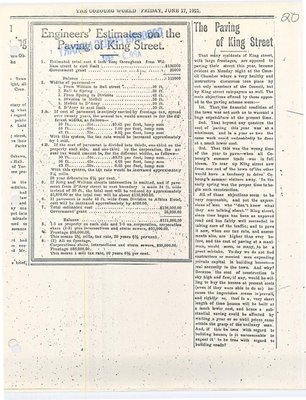That many residents of King street, with large frontages, are opposed to paving their street this year, became evident on Monday night at the Council Chamber where a very healthy and instructive discussion took place by not only members of the Council, but by King street ratepayers as well. The main objections offered by those opposed to the paving scheme were:--
1st. That the financial condition of the town was not such as to warrant a huge expenditure at the present time.
2nd. That beyond any question the cost of paving this year was at a maximum, and in a year or two the same work could undoubtedly be done at a much lower cost.
3rd. That this was the wrong time of the year to pave—when all Cobourg’s summer trade was in full bloom. To tear up King street now from one end of the town to the other would have a tendency to drive Cobourg’s summer visitors away. In the early spring was the proper time to begin such construction.
All of these objections seem to be very reasonable, and not the expressions of men who “don’t know what they are talking about.” King street, since time began has been an unpaved road and has fairly well succeeded in taking care of the traffic; and to pave it now, when our tax rate, and assessments also, are higher than ever before, and the cost of paving at a maximum, would seem, to many, to be a great mistake. To-day we do not find contractors or monied men expending private capital in building houses—a real necessity to the town. And why? Because the cost of construction is sky high and few, if any, would be willing to buy the houses at present costs (even if they were able to do so) because the impression seems to prevail, ad rightly so, that in a very short length of time houses will be built at a much lower cost, and hence a substantial saving could be affected by waiting a year or so until prices came within the grasp of the ordinary man. And, if this be true with regard to building houses, is it unreasonable to expect it to be true with regard to building roads?
1. Estimated total cost 6 inch base throughout from William street to east
limit………………………………………….$136000
Government grant……………….…………….25000
Balance………………………………..…..…111000
2. Widths of pavements—
1. From William to Ball street…….….…...30 ft
2. Ball to Spring………………………..…..36 ft
3. From Spring to Division………………..42 ft
4. Division to McGill…………………….…36 ft
6. D’arcy to east limit………………….…..30 ft
3A. If cost of pavement is entirely carried out by frontage tax, spread over
twenty years, the annual tax would amount to for the different widths, as
follows—
30 ft……….51c………………….$5.65 per foot, lump sum
36 ft….…….63c…………………..7.00 per foot, lump sum
43 ft………..50c…………….…….8.30 per foot, lump sum
With this system, the tax rate would be increased approximately by 1 mill.
4B. If the cost of pavement is divided into thirds, on third on the property
each side, and one-third by the corporation, the annual tax would amount
to, for the different widths, as follows—
30 ft…………34c……………..$3.75 per foot, lump sum
36 ft………...42c……….………4.65 per foot, lump sum
43 ft………....50c……….……...5.65 per foot, lump sum
With this system, the tax rate would be increased approximately 2 ¼ mills.
20 year debentures 6 ½ per cent.
5. If King and William streets intersection is omitted, and if pavement
from D’Arcy street to east boundary is made 24 ft. wide instead of 30
ft., the total coast will be reduced by approximately $5,800.00 or the
total cost will be about $130,000.00.
6. If pavement is made 42 ft. wide from Division to Albion Hotel, cost will
be increased approximately by $500.00.
7. Total estimated cost……………………….$136,000.00
Government grants………………………..…. 25,000.00
Balance…………………………..……………$111,000.00
8. 1-3 on property on each side and 1-3 on corporation, corporation
share (1-3) plus intersections and storm sewers, $53,000.00.
Frontage $58,000.00.
This means 2 ¼ mills, tax rate, 20 years 6 ½ per cent.
9. (2) All on frontage.
Corporations share, intersections and storm sewers, $25,000.00.
Frontage $86,000.00.
This means 1 mill tax rate, 20 years 6 ½ per cent.


